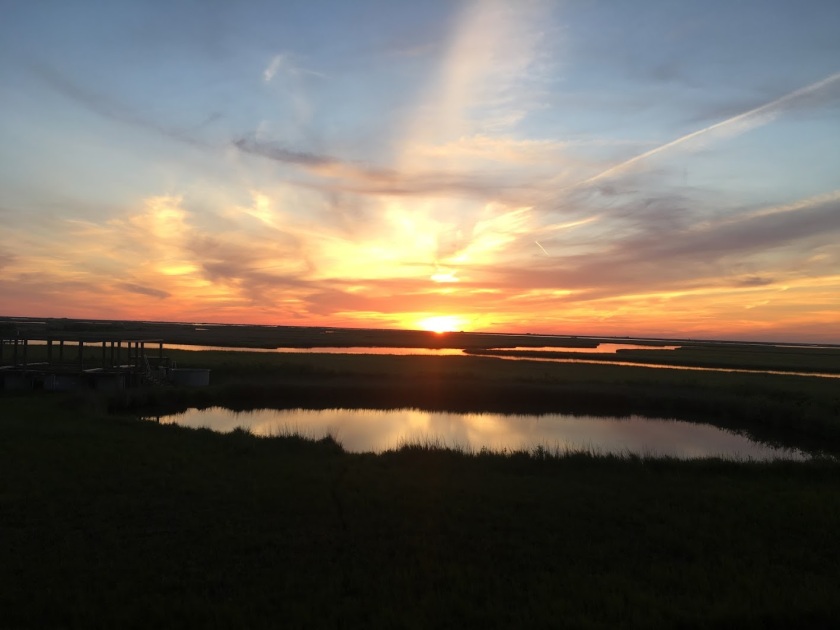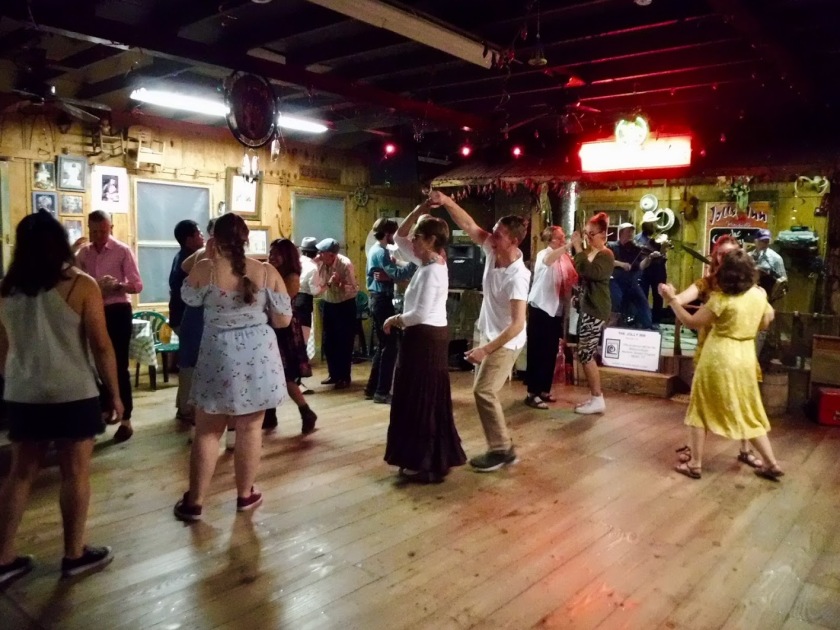by Hayden Gillooly
Hayden Gillooly is one of our student bloggers for Spring 2019. She is a sophomore at Williams College, studying Spanish and Geosciences with a concentration in Maritime Studies. She is from North, Adams, MA.

One sunny day, I was walking through the Seaport with my friend and science partner, Phoebe. We were on our way to deploy equipment for our science project: a series of ropes with plastic attached at various depths, to see how depth affects the diversity and biomass of sessile fouling marine organisms. Wagon in tow, filled with buoys, zip ties, and our ‘deployment chains,’ we weaved our way through the Seaport, and noticed that there was a sign in front of the Mystic Chapel that said there would be a chantey singing performance at 1:30. It was 1:27. Perfect! Sessile marine organisms could wait.
We parked our science wagon and went inside, only to find that the church was empty. A museum-goer entered, and we struck up a conversation. We ended up talking about our research projects, and the visitor knew something about all of our topics. He had read the same books we had read, and even knew the cases we had studied in Marine Policy! We exchanged emails, and I promised I would follow up to interview him for my Marine Policy project, which looks at sustainable fishing through a sociological lens. It was such a serendipitous encounter; Phoebe and I walked away feeling energized and excited.
I emailed him last week, and he responded, putting me in touch with another gentleman as well. That gentleman said, “We save what we love. We love what we know. We know what we experience” (a mixture of his ideas along with that of Jacques Cousteau and others). It made me think about Mystic immediately. Here, we are learning to love the planet through learning and experiencing it. How glorious.
Specifically, it made me think about our trip to Louisiana earlier this month. For years, I have learned about global warming, but nothing felt so relevant and necessary as learning about it in Louisiana and speaking with people directly impacted by climate change and sea level rise. No textbook can bring a story and concept to life like experiences can. We only know what we experience.
In Louisiana, driving in our rented minivans vans over a bridge, we could see wetlands disappearing. The bridge itself did not exist just five years prior; the road it replaced was already underwater. We saw ‘ghost trees,’ which are dead trees that have been killed by saltwater as sea level rises. They look eerie and haunting, scattered along roads and highways: A reminder that the sea did not used to come this far.

While traveling through Louisiana, I was amazed by the kindness of everyone we encountered. They welcomed us with open arms, eager to talk to us and answer our questions. Williams-Mystic has built such special relationships with people there. After visiting semester after semester, the program has found a family in these people. It was magical to watch our professors’ faces light up when they saw these old friends. At Cajun dancing one night, the dancers pulled us into their routine with tenderness and joy; before we knew it, we were doing line dances with huge smiles across our faces. The sound of the washboard, band, and laughter filled the dance hall.

While learning about sea level rise in the classroom, I always wondered (albeit naively), why, if someone had the means to, they would not just move. After this trip, I learned that the answer is not so simple; it is full of intricacies, complexities, and does not really have one answer at all. As we spent time with our hosts in Louisiana, I felt my understanding shift. Chief Shirell Parfait-Dardar, of the Grand Caillou/Dulac Band of Biloxi-Chitimacha-Choctaw, talked to us about how sea level rise is inundating and flooding the burial grounds of her tribe’s ancestors. Mr. Carl Sevin, a vessels technician at the Louisiana Universities Marine Consortium (LUMCON), talked to us about how his job, like so many others, is dependent upon this place. While his wife is a biology teacher and can find employment elsewhere, his livelihood is dependent upon the land of Louisiana.

At an oyster hatchery, we learned that 47% of US oysters are from Louisiana, and that oyster reefs can protect coasts from erosion and storm surge. A threat that is facing this industry is that the Gulf of Mexico has been identified as highly vulnerable to ocean acidification. Sediment buildup can also be a threat to these crucial oysters reefs, along with attempts to build out the coast by importing sediment. As Brian Callam at the Louisiana WLF Oyster Research Lab said, “When you build up land mass where it was open water, then people who were exploiting that water are displaced. Real people are affected, and their everyday lives, by these changes.”
In the town of Grand Isle, on Louisiana’s only inhabited barrier island, we spoke with Mr. Chris Hernandez, the town supervisor and right-hand man to Mayor David Camardelle. Living in western Massachusetts, far away from the coast, it is hard for me to imagine preparing for hurricanes and having my home flooded by rising waters. Conversations with Mr. Chris in his ‘man cave’ were humbling and gave me chills. “When you think you’re prepared for a hurricane, you’re not. You’re never prepared enough.” At Mr. Chris’ house, we also spoke with Captain Floyd Lasseigne; he said that with marshland disappearing, there are fewer places for shrimp to lay their eggs, resulting in declining stocks.
The way that Mayor David talked about Grand Isle reaffirmed that it truly is people who make a place and build a community. “Our homes are gone, but we have our lives.” He described saving a homeless man from drowning in a flooded street during Hurricane Katrina; that man still calls him every few months to thank him. Mr. Chris said that if anything, people must help each other. Even when they have nothing, they help.
On the last night of each field seminar, we do an exercise called ‘around the room,’ where each of us takes a turn reflecting on the trip. I always find these conversations to be eye-opening. Everyone’s comments made me think about the trip through another lens, deepening my appreciation for the experience. My classmate and friend, Angus Warren, said something in his reflection that stuck with many of us. He said, “Is what I am doing good for others?” I followed up with Angus about his comment. He replied, “I am filled with anxiety that my chosen discipline [Classics] serves nothing and no one apart from myself. I have the same reaction to working on sailing ships: sure, I would love to spend the rest of my days floating around the world, but what good am I doing? Being down in Louisiana, amongst people for whom Latin is nothing more than a long-dead language, has hammered home my dread that I’ve isolated myself from large segments of the very same ‘humanity’ I purport to study.”
We furthered our conversation over coffee with my friend and housemate Kylie Wiegel. We questioned what it meant to live a meaningful life and to make a difference in the world. We concluded that if we cannot change the whole world, perhaps we should focus on perpetuating a ‘locus of passion.’ That is, delving into our passions, and sharing them with the people around us so that a cycle of passion is fostered. I find that at Williams-Mystic, in-class discussions often lead to philosophical chats after class and during meals; the topics we are studying feel so relevant and necessary to engage with.
Our trip to Louisiana showed me how climate adaptation, mitigation, and resiliency look different everywhere. In southern Louisiana, community itself is a form of resilience. Traveling there showed me the face behind climate change; there is no better textbook than a storyteller sitting in front of you.
I left the trip feeling changed by the experience, wanting to further study global warming and environmental sciences. Angus’ question rang through my head on repeat: “Is what I am doing good for others?” A week after returning from the trip, I decided to add a Geosciences major with a concentration in Maritime Studies to my Spanish major. My Geosciences professor at Williams, José Constantine, always described climate change by saying “That’s your brothers and sisters out there.” I nodded in agreement in class, but did not feel this line until this trip. How can we stare climate change in the face for what it is? This is more than merely a scientific or political issue: it is an inherently human issue.
